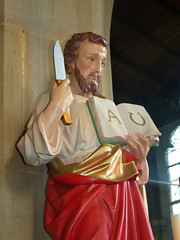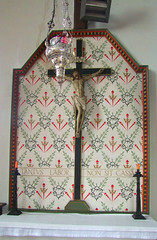| |
|
 |
|
St Bartholomew's church is
unusual for several reasons, which are all to
varying degrees apparent to the casual observer.
Firstly, its setting. It stands with Victorian
terraced houses all around. Apart from a small
Methodist church a block away, there are no other
significant buildings. It is a very domestic
setting that lends the church a high degree of
grandeur. This is Rose Hill, a Victorian railway
suburb. Derby Road railway station lies just 100m
away up Rose Hill Road.
The church is slightly later in date than many of
the houses, consecrated in 1895 and completed in
1907. The architect was Charles Spooner, who
seems to have had an Italian hilltop village in
mind, rather than anything from this side of the
Alps. The great flamboyante east window
of this fine building overlooks vegetable plots
and garden sheds, just as he intended it should.
The red-brick exterior was planned to be offset
by a tower, but this was never built. You can see
where it would have been, to the north west. A
lawn is there now.St
Bartholomew was Charles Spooner's first church.
He built it for his aunt Anna Spooner, who had
been born Anna Cobbold. She came from a branch of
the famous Ipswich family which had provided a
number of Suffolk High Churchmen, the most famous
of whom was Richard Cobbold, rector of Wortham
and author of Margaret Catchpole, among
other books. She was married to Edward Spooner,
rector of Hadleigh, and her nephew George Cobbold
was the first vicar of St Bartholomew, which
seems to have been intended from the start. The
church was provided as Ipswich's first
purpose-built, thorough-going Anglo-Catholic
church, a tradition it has maintained to a degree
up until today.
|
You step into an interior which is
now quite unlike any other Suffolk church. This great
space is alive with colour and light. Altars and shrines
are all around, but there is no sense of clutter, partly
because of the apparent squareness of the nave, but
mainly because your eyes are drawn eastward to the
sanctuary and great east window. The hanging behind the
altar, by Morris and Co, lifts the eyes into the gloom of
the roof space, which is then shot through with light
from above.
| The simplicity of the rows
of chairs, and the austere beauty of the high
arcades, contribute to an experience unique in
Suffolk, otherwise the most singularly Low Church
of English counties. Looking
west, the elevation is flooded with light from
the great seven-light window. Spooner's plans
envisaded twelve-lights, which would perhaps have
detracted somewhat from the east end, especially
at evensong on a sunny evening. And yet, St
Bartholomew might have been even more beautiful
than it is. In the 1920s, a vast scheme of glass
by the great Christopher Whall was planned, but
it was never executed. It certainly would have
made this a church of national significance.
A war memorial altar in the
north aisle bears a simple crucifix. This church
was brand new when the War that would change the
Church of England forever began, taking away boys
from the humble terraced streets all around.
Across the church is an altar to Our Lady of
Walsingham, one of only two in an Anglican church
in Ipswich. A new altar sits in the nave, but
still the great high altar with its six silver
candlesticks remains, a triumphant symbol of the
heady days of the Catholic revival. A cool little
chapel in memory of George Cobbold, designed by
Munro Cautley, sits beside the sanctuary. It is
probably his most successful work in a church
which was not his own. And all around, everything
is devotional and striking. In the 1920s, many
Anglican churches were like this, especially in
urban areas, but that is all now finished with,
especially in Suffolk. St Bart's now sits high
and dry, and attracts a congregation from all
over Ipswich.
|
|
 |
|
|
|

